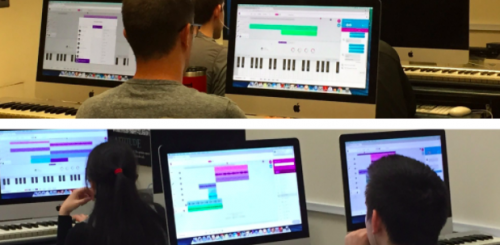
Curriculum Keeps Baltimore Engaged with Music
July 15, 2021Educator Rod Hamilton’s relevant music curriculum taught through Soundtrap helped Baltimore City Public Schools students experience new musical perspectives throughout the pandemic
Rod Hamilton teaches music at Mergenthaler High School (Mervo) in Baltimore City Public Schools. When the pandemic hit last March and the district was forced to send the kids home, Rod, like many of his peers, was at a loss. “I didn’t know what to do. I was trying different things and asking my students to download apps on their phones,” said Hamilton. “It was just a mess, and I didn’t feel like I could offer my best teaching. I began searching for things and I came across Soundtrap.” Similarly, arts supervisors were trying to reconcile virtual instruction with performing arts disciplines in a way that was meaningful, addressed the social and emotional needs of students, and would not require a drastic learning curve for teachers.
Hamilton’s class had traditionally been an instrumental music program, which couldn’t carry over into the remote world. He was familiar with some different digital audio workstations (DAW), however, having taught them in an after-school recording club. When he found Soundtrap, though, there was something new. He found a tool that was more intuitive, and that easy-to-learn benefit carried over to the students, as well.
He collaborated with Chan’nel Howard, the district’s Fine Arts Supervisor, and they agreed to purchase Soundtrap for the district. Hamilton would lead the writing of a curriculum that uses Soundtrap to help teach the fundamentals of music through a student-centered social justice lens. Both Howard and Hamilton saw this as an opportunity to revamp and re-energize the existing Survey of Music curriculum―to provide an option as well as to make the class a much more palatable experience for both students and teachers.
“I spent all summer just making a lesson plan for every single day,” said Hamilton. “So, by the first day of school, teachers, including me, would have a curriculum. It’s cool because now I’m thinking about how we will do this moving forward when we return to in-person learning. I’d like to incorporate this because, for the first time, I am teaching things like music concepts that I don’t usually get to teach in a traditional band room or a general music class. Now, I’m talking about reverb and distortion and audio effects, as well as panning and quantization and automation … so many concepts.”
Hamilton has used his expertise in music, as well as a diligent approach to ensuring relevance to students, to create a curriculum that truly leverages the best of what Soundtrap can offer. His ability to make the lessons current and compelling means a great deal to his students, and it helped keep attendance strong despite the challenges many students faced in engaging with a full year of remote learning.
Here’s an example of the instruction he delivered over Zoom:
One of the great things about Soundtrap, according to Hamilton, is it allows his students to work together. “Once I get to Unit 3, I start to have them collaborate with each other. They can remix each other’s work. It’s been nice to see students actually talk to each other. None of my students share their screens―they only type in the chat to me, but now they can actually chat to each other in Soundtrap. And even if it’s off-topic, it’s still cool because we’re in this box of isolation during the pandemic. The collaboration function has allowed students to still feel like they’re in some kind of classroom.”
Hamilton has gone to great lengths to ensure the curriculum is not only fun, but it is also relevant. The BCPS arts curricula intentionally includes social justice themes and student voice. Hamilton’s Soundtrap curriculum provides a great example of this in action: “In terms of social justice, I start them off with analyzing lyrics. For example, there’s a song called The Bigger Picture (by Lil Baby). It’s a newer song, so I knew the students would like it. After they remix the instrumentals, they take things that he says and, through copying and pasting and splitting the regions, take sections of his beats.”
From there, Hamilton will demonstrate similar themes from Marvin Gaye’s What’s Going On and maybe add in a clip of Tupac Shakur being interviewed, along with clips from current events. “These are teachable moments and I don’t think we should shy away from them,” he says.
In all, Hamilton’s success with the curriculum stems from his belief that music education should “go right to the hook,” meaning class should get kids talking about music and artists that interest them. This includes creating an environment that allows them to express themselves and discuss songs with purpose, such as the songs with social justice messages, but also preparing students to have deeper discussions about the musicality present in recordings they know. How did the artist use phrasing, note choice, augmentation, diminution, tension, and tonality to emphasize what they’re communicating? How could they have done something different to increase the emotion? Students begin to talk about music critically―providing an aesthetic critique, analyzing it as practitioners and creators.
The curriculum has really taken off across Baltimore City Public Schools, too. Hamilton created a Google Classroom page in which he shares all his resources, and more than 50 teachers have accessed the account. As educators across the district look ahead to the next school year, they’ll surely be eyeing opportunities to build on this exciting new curriculum.
 EDU Portal
EDU Portal


